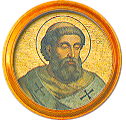Gregory
(Pope Gregory III)
Syria
Son of [father unknown] and [mother unknown]
[sibling(s) unknown]
[spouse(s) unknown]
[children unknown]
Died
[location unknown]
Profile last modified
| Created 27 Apr 2021
This page has been accessed 361 times.
| Preceded by Gregory II |
90th Pope of the Roman Catholic Church 18 March 731 - 28 November 741 |
Succeeded by Zachary |
Biography
Gregory was the son of a Syrian named John.[1][2] The Vatican gives his birth place as Syria.[2]
He was consecrated pope on 18 March 731.[2][1]
He established the monastery of St Chrysogonus and rebuilt the hospice of Saints Sergius and Bacchus near St Peter's Basilica, providing it with an endowment to support the poor.[1]
Flocknote Popes in a Year [3] says:
- Gregory III, a member of the Roman clergy before being pope, was apparently so popular that during Gregory II’s funeral he was chosen as successor by popular acclamation. A month later, on March 18, 731, Gregory III was consecrated as the 90th pope. Around the year 737, Gregory welcomed St. Boniface back to Rome for an update on the evangelization of Germany, then recommissioned the bishop with the assistance of St. Willibald, Boniface’s cousin.
- Amazingly, several letters still exist from Gregory to Boniface, including the one sending the great saint again on mission into Germany:
- "Your holy purpose, as it has been explained to us, and your well-tried faith lead us to make use of your services in spreading the Gospel, which by the grace of God has been committed to our care." - Pope St. Gregory III to St. Boniface
- Toward the end of his papacy, Gregory dealt with a particularly vicious Lombard onslaught that spanned several years, pleading for help from the Franks and Charles Martel, and working to protect the city of Rome from the attackers. Before the fighting was over, in 741, Gregory died and was buried in the oratory he had built in the crypts of St. Peter’s Basilica. His feast day is November 28.
- Gregory III took after the previous Gregory and battled Emperor Leo III for most of his pontificate. With iconoclasm (the heresy that commanded destruction of holy images) still in high gear, Gregory made it a point to especially emphasize the use of images and relics, especially those of St. Peter, just to stick it to the emperor. In addition, Gregory convened two synods in Rome in 731 to explicitly condemn the heresy, had an oratory built in the crypts of St. Peter’s, and also wrote several prayers to be recited there.
- However, the pope-emperor showdown wasn’t limited to iconoclasm. Leo didn’t appreciate being disobeyed and thus used force to make his point whenever possible. Though an attack fleet he sent to Italy was a failure, he then took a precarious step that particularly peeved those in Rome: He stole papal lands in the Balkans and reassigned them to the Patriarch of Constantinople. The move weakened the allegiance those in Western Europe felt toward the emperor, and scholars suggest that it was a definitive step toward schism in the coming centuries.
- The first three popes bearing the name “Gregory” are all recognized as saints. This trend actually occurs three times in papal history: the first three Popes Sixtus and Popes Leo also are honored as such.
- The Venerable Bede, the great English saint and monk, finished his monumental work Historia ecclesiastica Gentis Anglorum (“Ecclesiastical History of the English People”) in 731 at the age of 59. The book, a rich history of Christianity in England up to that time, is still regarded as one of the landmark reference works on Anglo-Saxon history, and helped to form the English national identity to boot.
He died on 28 November 741 and was buried in St Peter's Basilica.[1][2]
Research Notes
![]() This profile is being updated by the Popes Project.
This profile is being updated by the Popes Project.
Sources
- ↑ 1.0 1.1 1.2 1.3 Wikipedia Pope Gregory III
- ↑ 2.0 2.1 2.2 2.3 Vatican
- ↑ Flocknote Popes in a Year
SOURCES (and further reading)
John, E. (1964). The Popes: A concise biographical history. New York: Hawthorn Books.
Pope St. Gregory III - http://www.newadvent.org/cathen/06789a.htm
Pope Gregory III - https://en.wikipedia.org/wiki/Pope_Gregory_III
Ecclesiastical History of the English People - https://en.wikipedia.org/wiki/Ecclesiastical_History_of_the_English_People
Is Pope Gregory III your relative? Please don't go away!
 Login to collaborate or comment, or
Login to collaborate or comment, or
 contact
contact
 the profile manager, or
the profile manager, or
 ask our community of genealogists a question.
ask our community of genealogists a question.
Sponsored Search by Ancestry.com
DNA
No known carriers of Pope Gregory III's ancestors' DNA have taken a DNA test. Have you taken a test? If so, login to add it. If not, see our friends at Ancestry DNA.
No known carriers of Pope Gregory III's ancestors' DNA have taken a DNA test. Have you taken a test? If so, login to add it. If not, see our friends at Ancestry DNA.
Images: 1
Comments
Leave a message for others who see this profile.
There are no comments yet.
Login to post a comment.
Categories: Byzantine Papacy | 8th Century | Catholic Popes | Notables


